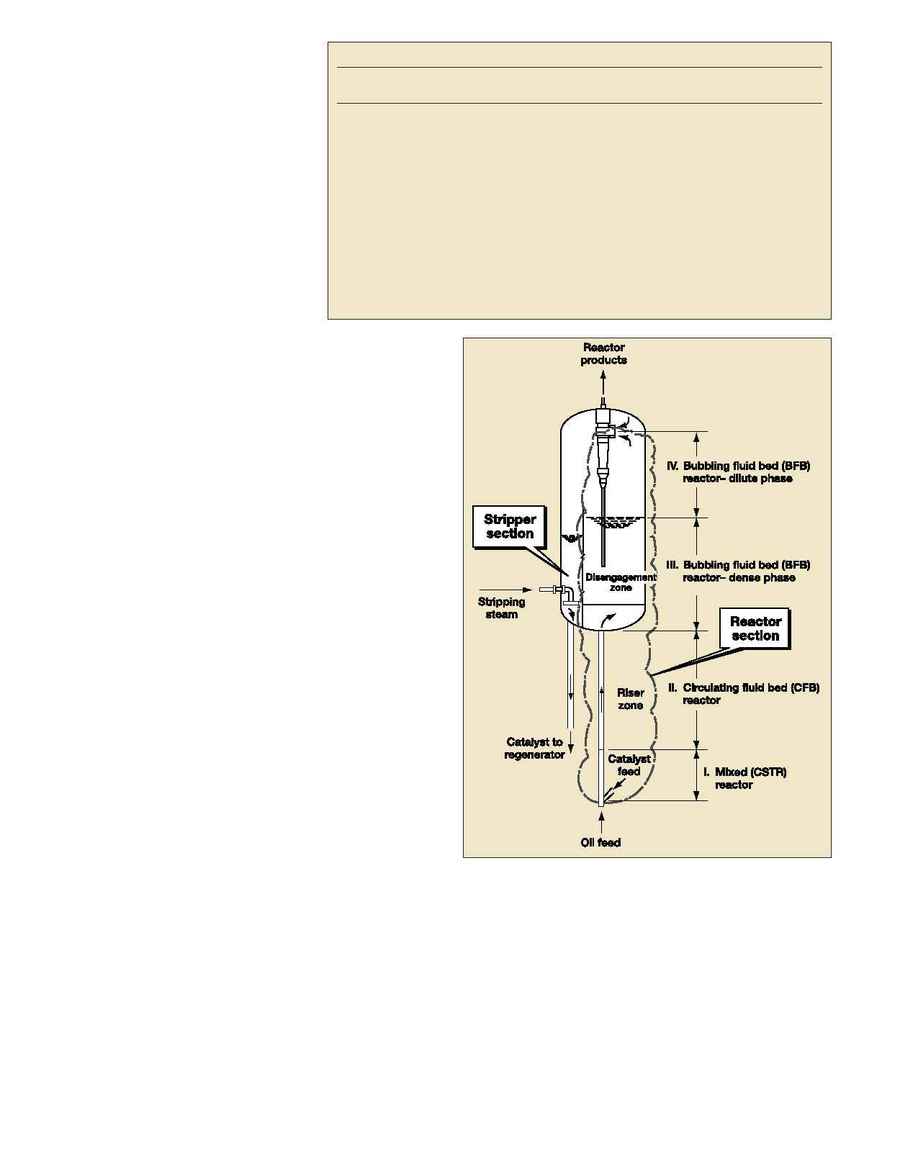
HYDROCARBON PROCESSING / JULY 1999
atures. The fixed-bed reactor cannot
be operated at as high temperatures
as intended due to heat transfer limi-
tation, which leads to a temperature
runaway within the reactor tube. A
circulating fluidized-bed (CFB) reac-
tor may offer equal or better MTY than
a BFB since the CFB can also be oper-
ated at a higher temperature. How-
ever, the CFB would require a very tall
reactor to achieve a conversion com-
parable to BFB.
In the projections shown in Table
2, the same feed gas composition has
also been assumed for all three reactor
types. In reality, due to safety reason,
the allowable propylene content for
the fixed-bed reactor has to be much
lower than the value used. With this more diluted feed,
the fixed-bed reactor would be even more unattractive
than that indicated by the table.
A performance projection by a general reactor model,
as shown in Table 2, thus allows the user to promptly
evaluate design alternatives and select the best design for
primary consideration. Developing a suitable catalyst
that has resistance to attrition when used in a BFB or
CFB reactor, with minimum loss of activity and selec-
tivity, is a parallel consideration. Other factors, such as
mechanical aspects, cost of the reactor, reactor safety and
operational flexibility, would play a role in the final deci-
sion.
The results depend on the actual mechanism and
kinetics that may vary substantially with actual cata-
lyst formulation. However, once a given catalyst perfor-
mance data are available or generated through a small
test facility, commercial projections (as shown in Table 2)
can be made with a fair degree of accuracy. The best
reactor configuration or the optimum operating condi-
tions of an existing unit can then be easily established.
The general model can be used to screen alternate reac-
tor design concepts for many other catalytic and noncat-
alytic reaction systems. These include: butane to maleic
anhydride, naphthalene to phthalic anhydride, oxidative
coupling of methane, hot gas desulfurization by zinc
titanate and partial oxidation of paraffins. The model can
be used to simulate lab, pilot-plant and commercial data
from other reaction and reactor systems that include FCC
catalyst regeneration in a CFB reactor, methanol synthe-
sis in a double-wall tubular super-converter and ammo-
nia synthesis in multistage adiabatic quench reactor.
EXAMPLE 2-CONVERSION OF
HEAVY HYDROCARBONS
In this example, the reactor model is used as a kinetic
modeling tool for a typical refinery process that cat-
alytically converts heavy hydrocarbon feedstocks. It is
carried out in the vapor phase where feedstocks undergo
many reactions including: hydrocracking, isomerization,
alkylation, cyclization, hydrogenation and de-hydro-
genation to form lighter products. A schematic reaction
network for the process is shown in Fig. 3.
To formulate a preliminary reaction mechanism for the
product compositions, numerous process compounds are
first divided into seven compound groups, i.e., heavy paraf-
fins (Hv Par), light paraffins (Lt Par), heavy naphthenes
(Hv Nap), heavy aromatics (Hv Aro), gaseous hydrocar-
bons (Gas), light naphthenes (Lt Nap) and light aromatics
(Lt Aro). Heavy and light paraffins are again subdivided
into normal and iso- paraffins (Hv n-Par, Hv i-Par, Lt n-Par
and Lt i-Par). The compound groupings are:
Hv Par: C
9
+
, i-C
9
+
Lt Par: C
5
C
8
, i-C
5
to i-C
8
Hv Nap: Nap C
9
+
Hv Aro: Aro C
9
+
Lt Nap: Nap C
5
C
8
Lt Aro: Aro C
6
C
8
Gas: C
3
, C
4
, i-C
3
, i-C
4
, C
3
=
, C
4
=
, product gases
Each compound group is then represented by a model
compound so that reaction stoichiometry can be easily
Table 3. Heavy hydrocarbons conversion reaction mechanism
With symbols
With model
Reaction
compounds
number
Hv n-Par + H
2
ßà Lt n-Par + Gases
nP-C
9
H
20
+ H
2
ßànP-C
6
H
14
+ C
3
H
8
1
Hv i-Par + H
2
ßà Lt i-Par + Gases
iP-C
9
H
20
+ H
2
ßàiP-C
6
H
14
+ C
3
H
8
2
Hv n-Par
ßà Hv i-Par
nP-C
9
H
20
ßàiP-C
9
H
20
3
Lt n-Par
ßà Lt i-Par
nP-C
6
H
14
ßàiP-C
6
H
14
4
Hv Nap + H
2
ßà Lt Nap + Gases
N-C
9
H
18
+ H
2
ßàN-C
6
H
12
+ C
3
H
8
5
Hv Aro + H
2
ßà Lt Aro + Gases
A-C
9
H
12
+ H
2
ßàA-C
6
H
6
+ C
3
H
8
6
Lt Aro + H
2
ßà Lt Nap
A-C
6
H
6
+ 3H
2
ßàN-C
6
H
12
7
Lt n-Par + H
2
ßà Gases
nP-C
6
H
14
+ H
2
ßà2C
3
H
8
8
Lt i-Par + H
2
ßà Gases
iP-C
6
H
14
+ H
2
ßà2C
3
H
8
9
Lt Nap + H
2
ßà Gases
N-C
6
H
12
+ 2H
2
ßà2C
3
H
8
10
Lt Aro + H
2
ßà Gases
A-C
6
H
6
+ 5H
2
ßà2C
3
H
8
11
Fig. 4. FCC simulation with a general reactor model.
